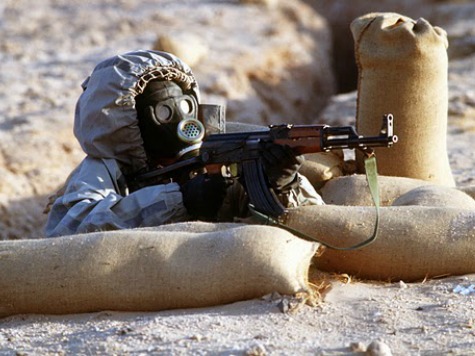Syrian forces loyal to President Bashar Assad have used chemical weapons in over 30 cases since Syria joined the Chemical Weapons Convention last year and agreed to the destruction of its entire arsenal, reports The Times of Israel.
“From the day that he signed the deal, [Assad] has used chemical weapons over thirty times, and in every case citizens were killed,” a senior Israel Defense Forces officer said, adding that the weapons were “tactically deployed” with mortars and short-range rockets.
The frequency of the chemical attacks brings into question just what was accomplished last September when Secretary of State John Kerry and President Barack Obama backed away from an American military attack against Syria on condition that it rid itself of chemical weapons.
Obama had promised to unleash American firepower against the Assad regime as punishment any crossing of the “red line” of chemical warfare. But when evidence mounted that the regime had, in fact, used sarin gas in an attack that killed approximately 1,400 Syrians, Obama’s commitment to a military strike began to waver.
First, he conditioned any attack on specific Congressional authorization that would be difficult to obtain. Then, as debate about the use of force continued, Kerry mused publicly about how the Syrians might avoid an attack by giving up their chemical arsenal. Russian President Vladimir Putin jumped at this “offer” and his Syrian allies agreed to dodge military strikes by giving up their chemical weapons.
The Syrians have since been turning over chemical stockpiles to international inspectors, but at a far slower pace than scheduled. There is some question as to whether the Assad regime has retained undeclared stockpiles.
According to the Israeli officer, who spoke on condition of anonymity, Assad’s regime is currently developing “non-classic” unconventional weapons based on weaker gases such as chlorine.
The officer asserted that Assad still aimed to produce weapons that could be deployed despite Syria’s membership in the CWC. “Our assessment is that [Assad] will attempt to retain a small stockpile, but he is constrained by the convention,” the officer said.
“That is why he is developing chemicals that, as I said before, are ‘non-classic’ — chlorine, for example.”
Chlorine and many other industrial compounds are not among the chemicals covered by Syria’s agreement to give up its arsenal.
Last week, the head of the Organization for the Prohibition of Chemical Weapons, Ahmet Uzumcu, announced the creation of a mission to “establish facts surrounding allegations of use of chlorine in Syria.”
The new probe comes after France and the United States alleged that Assad’s forces may have made tactical use of industrial chemicals on a rebel-held village in central Hama province last month.
“We have indications of the use of a toxic industrial chemical, probably chlorine, in Syria this month, in the opposition-dominated village of Kafr Zita,” White House spokesman Jay Carney said on April 21.
Activists have also reported other chlorine gas attacks, most recently in Idlib province, in the northwest, two weeks ago.
Syria, though behind schedule, has surrendered over 90 percent of its declared chemical weapons under the terms of the US- and Russia-brokered deal which headed off US military action last year. But between the possibility of undeclared stockpiles and stockpiles of chemicals which fall outside their agreement to surrender weapons, the Syrian regime remains a credible threat to attack with chemical weapons.

COMMENTS
Please let us know if you're having issues with commenting.